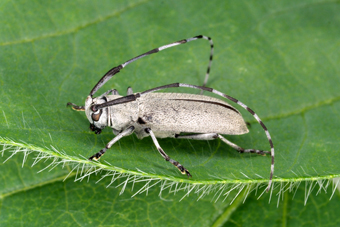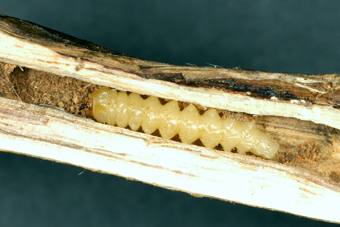G2082
Soybean Stem Borers in Nebraska
Identification, life cycle, injury symptoms, and cultural and chemical management of soybean stem borer.
Robert J. Wright, Extension Entomologist
Thomas E. Hunt, Extension Entomologist
|
The soybean stem borer, Dectes texanus texanus, is a long-horned beetle (Family Cerambycidae) native to the central U.S. It has a wide host range, including soybeans, sunflowers, and several broadleaf weeds, including cocklebur, ragweed, and wild sunflowers.
Soybean stem borer injury can be found in some south central Nebraska soybean fields. This beetle has been moving into Nebraska from north central Kansas over the last decade. It was first documented as a soybean pest near Hardy in Nuckolls County in 2000, and has been moving into south central Nebraska since then. Soybean stem borer injury has been reported on soybeans in Fillmore, Clay, and Saline counties and surrounding areas to the west, east, and south.
Description and Life Cycle
The adult is a gray, elongate beetle about 1/2 inch long with antennae that are longer than the body (Figure 1). The antennae have alternating black and gray bands. Females lay eggs singly from late June to August on various plants, including cocklebur, giant ragweed, sunflower, and soybean. On soybean, eggs are primarily laid in the leaf petioles. Larvae feed within the petiole and tunnel down into the main stem. Each of four larval stages tunnels up and down the stem.
Larvae are cream-colored, legless, and widest at the head with the body gradually narrowing to the tail end (Figure 2). Larvae are 1/2 to 5/8 inch long at maturity. The larvae are cannibalistic and only one larva will survive per plant. Larvae overwinter at the base of the plant in the stem. Pupation occurs in early summer and adult emergence begins in late June. Adults are active from late June through August. There is one generation per year.
Injury Symptoms
Initial injury is seen when larvae tunnel down the leaf petiole and enter the stem. The leaf tissue above this point wilts and dies (Figure 3). If you split the leaf petiole, you can see the tunneling and may still see the larva. The appearance of individual dead leaves in an otherwise healthy canopy can be an early indication of the presence of Dectes. Split the stems of these plants to confirm the presence or absence of Dectes larvae.
Larvae tunnel up and down the stem, and end up at the base of the plant at plant maturity. Mature larvae girdle the inside of the stem to make a cell for overwintering. This weakens the stem and may lead to stem breakage or lodging. Economic damage is caused primarily by lodging and subsequent harvest difficulties. Girdling is most severe in earlier maturing varieties, and lodging is most severe in earlier planted soybean. In the absence of harvest losses from lodging, direct yield loss from larval feeding has been limited or absent.
Management
Cultural Controls
Several cultural practices can be implemented to reduce potential loss from stem borers.
- Weed control to reduce alternate hosts of soybean stem borers, such as wild sunflower, ragweed, and cocklebur, can help reduce soybean stem borer populations.
- Research at Kansas State University indicates that Dectes prefers commercial sunflower to soybeans. Sunflowers may be used as a trap crop to protect adjacent soybean fields.
- Research from North Carolina has found that burying borer-infested stubble after harvest can reduce soybean stem borer populations the next year; however, this practice may not be desirable where soil erosion is a concern.
- The adults are not strong fliers and crop rotation may reduce damage in areas where soybean acreage is limited.
- Field observations in Kansas suggest that early planted, short-season varieties may be more likely to have harvest losses from lodging. Longer season varieties mature later in the year, allowing more time to harvest before lodging is likely.
- Entomologists at Kansas State University have been studying this insect as a pest on soybeans for several years. They have not identified resistance in any commercially available soybean cultivars.
Chemical Controls
Chemical treatment of larvae is ineffective because the larvae are in the stem; effective chemical control of the adults is difficult due to the extended adult emergence period. Research in Kansas indicates that multiple foliar insecticide applications are needed to significantly reduce adult populations and larval injury, and may not be economically justified unless harvest is late and lodging losses are high.
Recommendations for Harvest
Fields with a history of injury or with injury symptoms this year should be carefully watched during August and September. Fields with extensive stalk tunneling (greater than 50 percent of plants) by the soybean stem borer are most at risk for lodging and harvest losses, depending on weather conditions. Those fields should be targeted for harvest first to minimize harvest losses due to soybean stem borer injury. In the absence of lodging losses, this insect does not usually cause noticeable yield reductions.
This publication has been peer reviewed.
Visit the University of Nebraska–Lincoln Extension Publications Web site for more publications.
File under: Insects & Pests
Field Crop Insects
Issued May 2011


